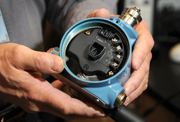- Number 305 |
- February 15, 2010
Helping industrial factories go wireless

Wireless sensors such as this
one
measure environmental
conditions such as temperature
and pressure and relay the data
to a control system.
Wireless technology inside factories is cheaper than cable connections, but the flow of information is not as reliable. That’s why an engineer at DOE's Idaho National Laboratory is devising and testing wireless sensor networks to help ensure the transition to wireless is safer for facilities with automated control systems. Wireless sensor networks are composed of sensors or nodes that monitor environmental conditions such as temperature and pressure. The nodes relay readings to a central point that connects to the control system, which then makes decisions based on the information. Transmitting and receiving sensory data in a timely and consistent manner is key to keeping the system running smoothly. INL engineer John Buttles is using INL's Center for Advanced Energy Studies to design a wireless sensor test bed where he can investigate vulnerabilities and weaknesses of such networks. The center’s wireless system, laboratories and office space provide an environment similar to an industrial setting. Buttles hopes the research will help establish design guidelines and standards, and improve the resilience of wireless sensor networks.
[Ryan Weeks, 208.526.0944,
ryan.weeks@inl.gov]
